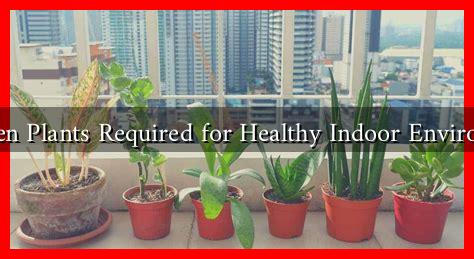-
Table of Contents
Are Green Plants Required for Healthy Indoor Environments?
In recent years, the importance of indoor air quality and overall well-being has gained significant attention. As urbanization increases and people spend more time indoors, the question arises: are green plants essential for maintaining a healthy indoor environment? This article explores the benefits of indoor plants, the science behind their impact on air quality, and practical considerations for incorporating them into our living and working spaces.
The Science Behind Indoor Plants and Air Quality
Indoor air quality can be significantly poorer than outdoor air quality due to pollutants from various sources, including furniture, cleaning products, and building materials. According to the Environmental Protection Agency (EPA), indoor air can be two to five times more polluted than outdoor air. This is where green plants come into play.
Research has shown that certain houseplants can improve indoor air quality by absorbing harmful toxins and releasing oxygen. A landmark study conducted by NASA in the late 1980s identified several plants that effectively remove common indoor pollutants such as formaldehyde, benzene, and trichloroethylene. Some of these plants include:
- Spider Plant (Chlorophytum comosum)
- Peace Lily (Spathiphyllum spp.)
- Boston Fern (Nephrolepis exaltata)
- Areca Palm (Dypsis lutescens)
Health Benefits of Indoor Plants
Beyond improving air quality, indoor plants offer a range of health benefits that contribute to a healthier indoor environment. Here are some key advantages:
- Stress Reduction: Studies have shown that being around plants can reduce stress levels. A study published in the Journal of Physiological Anthropology found that participants who interacted with indoor plants experienced lower blood pressure and reduced feelings of anxiety.
- Enhanced Mood: The presence of greenery can elevate mood and promote feelings of happiness. A study from the University of Technology in Sydney found that employees with plants in their workspace reported higher levels of job satisfaction and lower levels of fatigue.
- Improved Concentration and Productivity: Research indicates that plants can enhance cognitive function. A study published in the Journal of Environmental Psychology found that individuals working in environments with plants performed better on tasks requiring attention and memory.
Case Studies and Real-World Applications
Several organizations have recognized the benefits of incorporating plants into their indoor environments. For instance, a case study conducted at the University of Exeter revealed that introducing plants into office spaces led to a 15% increase in productivity among employees. Similarly, a tech company in San Francisco transformed its office by adding greenery, resulting in improved employee morale and reduced sick days.
Moreover, hospitals have also embraced the concept of biophilic design, which integrates nature into healthcare settings. Research published in the Journal of Environmental Psychology found that patients recovering in rooms with plants experienced shorter hospital stays and reported lower levels of pain and anxiety.
Practical Considerations for Indoor Plant Care
While the benefits of indoor plants are clear, it is essential to consider practical aspects when incorporating them into your environment:
- Choose the Right Plants: Select plants that are suitable for your indoor conditions, such as light levels and humidity. Low-maintenance options like snake plants and pothos are great for beginners.
- Placement Matters: Position plants where they can thrive and be easily seen. Consider placing them near windows or in well-lit areas.
- Regular Maintenance: Ensure proper care by watering, pruning, and repotting as needed. Regular maintenance will keep your plants healthy and thriving.
Conclusion
In conclusion, green plants play a vital role in creating healthy indoor environments. They not only improve air quality by filtering out toxins but also contribute to mental well-being, productivity, and overall health. As we continue to navigate urban living and spend more time indoors, incorporating plants into our spaces is not just a trend but a necessity for fostering a healthier lifestyle. By choosing the right plants and caring for them properly, we can enhance our indoor environments and reap the numerous benefits they offer.
For more information on the benefits of indoor plants, you can visit the EPA’s Indoor Air Quality page.

